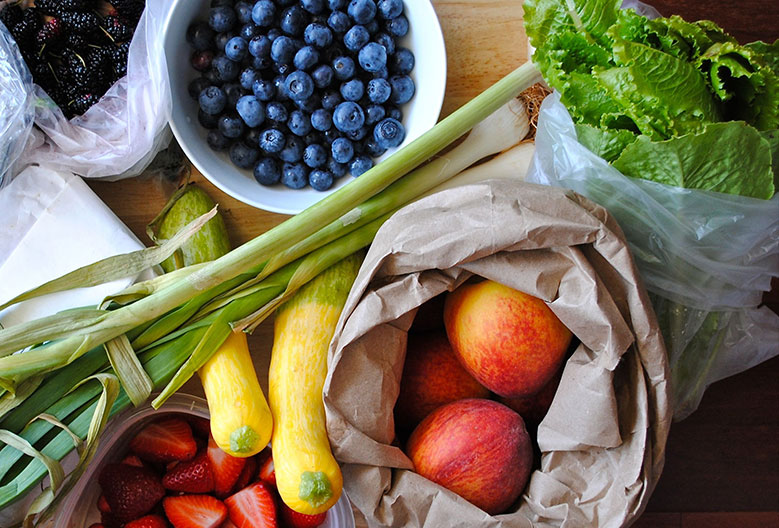- Mom said “eat your fruit and vegetables.” Mom was right!
- A diet rich in fruit and vegetable can be delicious. Open you mind to the possibilities.
- Fruits and vegetables should take-up half of your dinner plate.
Fruits and veggies: part of the healthy dietary pattern
The American Heart Association recommends adults should eat at least 4-5 cups of fruits and vegetables daily. However, only 9% of adults consume the recommended amount. Fruits and vegetables, rich in vitamins, minerals, fiber and phytochemicals have many health benefits, such as reducing heart disease, stroke, obesity, some cancer and type 2 diabetes.
Skip higher glycemic juice and go for whole fruit. Studies show that greater consumption of fruit juices was associated with a higher risk of type 2 diabetes. Eating more whole fruits, particularly blueberries, grapes, and apples, was significantly associated with a lower risk of type 2 diabetes, according to a new study led by Harvard School of Public Health researchers.
- Data gathered between 1984 and 2008 from 187,382 participants in the Nurses’ Health Study, Nurses’ Health Study II, and Health Professionals Follow-Up Study) reported that for those consuming at least two servings each week of certain whole fruits — particularly blueberries, grapes, and apples—their risk for type 2 diabetes was cut by as much as 23 percent in comparison to those who ate less than one serving per month. For those who consumed one or more servings of fruit juice each day increased their risk of developing type 2 diabetes by as much as 21 percent.
The researchers found that swapping three servings of juice per week for whole fruits would result in a 7 percent reduction in diabetes risk. The high glycemic index of fruit juice compared to that of fiber-rich fruit is believed the factor linking juice consumption and increased diabetes risk. Much of the benefit of fruits and vegetables is related to its fiber content -that is the stuff that remains in the “juicer.”
Previous studies have suggested a preliminary association with anthocyanins found in berries and grapes to lowered heart attack risk. The European Prospective Investigation Into Cancer and Nutrition (EPIC) was designed to investigate the relationships between diet, nutritional status, lifestyle and environmental factors and the incidence of cancer and other chronic diseases. EPIC is a large study of diet and health having recruited over half a million (520,000) people in ten European countries: Denmark, France, Germany, Greece, Italy, The Netherlands, Norway, Spain, Sweden and the United Kingdom.
- The relation between fruit and vegetable consumption and lowered chance of death from any cause was significantly and positively related to higher consumption of fruits and vegetables and the survival relationships were even stronger for raw than for cooked vegetable consumption.
- According to the 2007 expert report of the World Cancer Research Fund and the American Institute for Cancer Research, some types of vegetables and fruits possibly protect against certain types of cancer. Phytochemicals (plant-made chemicals) with biological activity, fiber, vitamins, antioxidants, plant hormones (isoflavones), and essential minerals are all present in fruits and vegetables and are considered among the important micronutrients.
- A major source in the US diet of anti-oxidant and anti-inflammatory phytochemicals called: anthocyanins are found in blueberries and strawberries. Other sources of anthocyanins were: eggplants, blackberries, and black currants. More than 3 servings per week of blueberries and strawberries (highest intake) compared to those at the lowest level was associated with a stunning 32% lower risk of a new heart attack in middle-aged women (Nurses’ Health Study 2, Circulation 2013).
- Habitual intake of colorful red and blue fruits and vegetables are a recurring theme with many large studies showing associations with important health benefits including lower blood pressure. In over 130,000 participants in the Nurses’ Health Study and the Health Professionals Follow-up Study a significant 8 mm Hg drop in blood pressure in those at highest intake compared to lowest intake of colorful fruits and vegetables was found. (American Journal of Clinical Nutrition, 2010).
Summary
Fruits and vegetables are a key part of a healthy meal plan. The American Heart Association recommends adults should eat at least 4-5 cups of fruits and vegetables daily. However, only 9% of adults consume the recommended amount. Fruits and vegetables, rich in vitamins, minerals, fiber and phytochemicals have many health benefits, such as reducing heart disease, stroke, obesity, some cancer and type 2 diabetes.
Learn more:
Plant-based Diets
Healthy Aging and the Mediterranean Dietary Pattern

